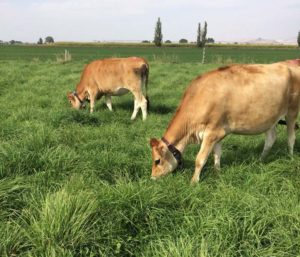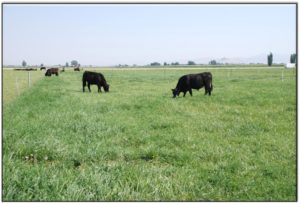Progress report for SW21-927
Project Information
In 2019, there were over 3.6 million dairy cows in the western U.S. [1], making dairy a dominant sector of the region’s agriculture. Organic milk production is becoming more prevalent, with organic products increasing from 1.92% to 4.38%, of all milk products sold, between 2006 and 2013 [2]. Organic milk companies promote their product based upon the health and environmental benefits of pasture-raised milk [3], and require at least 120 grazing days per year for both lactating cows and replacement heifers [4]. However, milk production is 32% lower in dairies using 75-100% of pasture-based forage compared to those using 25% or less pasture forage [5]. Insufficient dry matter intake (DMI) of pasture by dairy cows is a major factor limiting milk production [6], and it has been observed that some dairy breeds are more efficient grazers than others [7-9]. Therefore, improved feed efficiency - the relative ability of a cow to convert feed into growth or milk, is increasingly important in pasture-based dairy systems [10, 11].
This proposal expands our previous Western SARE projects that evaluated how grass-legume pastures with different energy, protein, and condensed tannin (CT) levels affected beef steer and Jersey heifer growth performance (SW10-088 and SW17-046). Those studies found that forage characteristics only explained 50% of the variation in DMI and average daily gain (ADG) [12, 13]. Furthermore, producers on our research team asked about the influence of dairy breed on performance within their pasture-based systems. Thus, we propose to investigate the effects of dairy breed, pasture type, and breed-by-pasture type interactions on DMI, feed efficiency, and environmental and economic sustainability of heifers raised in pasture-based systems. A multi-disciplinary team will conduct this research at the Utah State University Lewiston Pasture Research Facility where replicated pastures of grass monoculture (MONO) or grass-birdsfoot trefoil (MIXED) are established. Four breeds of dairy heifers (Holstein, Jersey, Holstein/Jersey crossbreds, and 3-way Holstein/Montbeliarde/Viking Red crossbreds [i.e., ProCROSS]) will be compared as they rotationally graze pasture treatments (MONO vs MIXED) throughout the summer. Producer cooperators will provide dairy heifers and participate in DMI and forage evaluation of pastures on their dairies.
Outreach is a major component of the proposal with contributions from university extension and eOrganic. This program will integrate traditional outreach with electronic media and be guided by input from producer cooperators and similar stakeholders. The primary targeted audiences will be dairy producers, Extension educators, NRCS personnel, and other professionals who advise farmers/ranchers. Emphasis will be on providing opportunities to train these individuals in the local area, statewide, and across the western region.
These objectives are in direct response to stakeholder feedback and are expected to identify differences in feed efficiency. It is anticipated that some breeds will respond to both high quality (MIXED) and lesser quality (MONO) pastures, whereas, some breeds will respond only to high-quality pastures. At the end of the research, we expect to provide producers with solid scientific AND economic data on pasture-based dairy heifer development for a variety of pasture-types and dairy breeds.
RESEARCH OBJECTIVES
Our long-term goal is to enhance the sustainability of pasture-based dairy. The central hypothesis of the current proposal is that genetic background (“breed”) will have a significant influence on the physiological responses of dairy heifers grazing grass/birdsfoot trefoil (MIXED) or grass-only (MONO) pastures, and these differences will be reflected in measures of environmental and economic sustainability. Specific research objectives are:
1: Determine the influence of dairy breed on DMI and feed efficiency in heifers grazing either grass-monoculture or grass/birdsfoot trefoil mixed pastures. We hypothesize that DMI and feed efficiency will differ across breeds but will be greater in MIXED pastures compared to MONO pastures for all breeds. We also anticipate that some breeds will have greater feed efficiency relative to other breeds on lesser quality pastures.
2: Evaluate the influence of dairy breed on nutrient leaching when grazing either grass-monoculture or grass/birdsfoot trefoil mixed pastures. We hypothesize that animals grazing the pastures with the CT-containing birdsfoot trefoil (MIXED) will have improved nitrogen (N) utilization as measured by reduced N in groundwater leachate compared to those grazing grass monocultures, and that greater feed efficiency will be associated with greater N-utilization efficiency.
3: Ascertain the influence of dairy breed on the economic sustainability of pasture-based heifer development. We hypothesize that heifer breed/pasture type combinations with relatively greater feed efficiency will have greater annual net financial impact and reduced payback period.
EDUCATION OBJECTIVES
As part of our long-term goal to enhance the sustainability of pasture-based dairy, we will implement an innovative and impactful multi-faceted extension/outreach program on the production and environmental benefits of pasture-based dairy heifer development. Pasture-based milk production is a fast-growing segment of agriculture in the Intermountain West and this project will bridge the gap in urgently needed information regarding breed and pasture-type differences. We have devised a solid research plan that will generate a wealth of highly novel data across a very broad and multidisciplinary research spectrum. The results from this study will be of value to the scientific and pasture-based dairy farming communities in general, but our research/outreach effort is designed to translate this information to make a real difference to individual dairy farmers and their families throughout the Intermountain West. Specific education objectives are:
1: Implement an innovative and impactful multi-faceted extension/outreach program for producers and professionals in the local area, statewide, and across the western region on the production, environmental, and economic benefits of grass/legume grazing for pasture-based dairy production systems.
2: Create and pilot the Intermountain Regional Dairy Grazing School.
3: Produce and publish scholarly and educational products.
See attached pdf for a picture of the Excel Gantt chart that will be used for this research project.
Cooperators
- - Producer
- - Producer
- (Researcher)
- (Educator)
- (Researcher)
- (Researcher)
- - Producer
Research
The central hypothesis of the current proposal is that genetic background (“breed”) will have a significant influence on the physiological responses of dairy heifers grazing grass/birdsfoot trefoil (MIXED) or grass-only (MONO) pastures, and these differences will be reflected in measures of environmental and economic sustainability.
OBJECTIVES
Our long-term goal is to enhance the sustainability of pasture-based dairy. The central hypothesis of the current proposal is that genetic background (“breed”) will have a significant influence on the physiological responses of dairy heifers grazing grass/birdsfoot trefoil (MIXED) or grass-only (MONO) pastures, and these differences will be reflected in measures of environmental and economic sustainability. Specific objectives are:
1: Determine the influence of dairy breed on DMI and feed efficiency in heifers grazing either grass-monoculture or grass/birdsfoot trefoil mixed pastures. We hypothesize that DMI and feed efficiency will differ across breeds but will be greater in MIXED pastures compared to MONO pastures for all breeds. We also anticipate that some breeds will have greater feed efficiency relative to other breeds on lesser quality pastures.
2: Evaluate the influence of dairy breed on nutrient leaching when grazing either grass-monoculture or grass/birdsfoot trefoil mixed pastures. We hypothesize that animals grazing the pastures with the CT-containing birdsfoot trefoil (MIXED) will have improved nitrogen (N) utilization as measured by reduced N in groundwater leachate compared to those grazing grass monocultures, and that greater feed efficiency will be associated with greater N-utilization efficiency.
3: Ascertain the influence of dairy breed on the economic sustainability of pasture-based heifer development. We hypothesize that heifer breed/pasture type combinations with relatively greater feed efficiency will have greater annual net financial impact and reduced payback period.
METHODS AND MATERIALS
USU Pastures and Grazing Details: This proposal will utilize previously established pastures, thus allowing completion of the study within the proposed timeframe. The experimental design and pasture experimental units will be formed by rearranging fencing on the established pastures to accommodate the treatments as described. The proposed study will be arranged as a 4 × 2 factorial with four levels of dairy breed and two levels of pasture-type [i.e., grass monoculture (MONO) and grass-BFT mixture (MIXED)]. This experiment will be conducted at the Utah State University Intermountain Pasture Research Farm (41°57'01.85" N, 111°52'15.75" W, elev. 1,369 m, 46 cm annual precipitation and 56.1 precipitation days/year) located near Lewiston, UT, USA. The soils are a Kidman fine sandy loam (Coarse-loamy, mixed, superactive, mesic Calcic Haploxerolls) and Lewiston Fine Sandy Loam (Coarse-loamy, mixed, superactive, mesic Calcic Haploxerolls). The site is within the semiarid Central Great Basin region of the western USA, characterized by hot, dry summers, and a majority of the annual precipitation as snowfall. Three 3.65-ha experimental pastures were established in June 2015, with the pastures arranged in a randomized complete block design to accommodate three technical replications. Within each of the three pasture replicates, endophyte-free tall fescue (‘Fawn’, TF), meadow bromegrass (‘Cache’, MB), high-sugar orchardgrass (‘Quickdraw’, OG), and high-sugar perennial ryegrass (‘Amazon’, PR) in monoculture and as binary mixtures with birdsfoot trefoil (‘Pardee’, BFT) were established in a strip-plot design [12]. Pastures have been managed using organic protocols, so no treatments have received pesticides or commercial fertilizer, but annually received 28 or 56 kg N/ha of organic approved nitrate. For the proposed study, Nature Safe organic N fertilizer (pelleted feather, meat, and blood meal, 13-0-0, Darling Ingredients Inc., Irving, TX) will be applied at 28 kg N/ha in May to all treatments (both monoculture and mixtures). Pastures are sprinkler irrigated every 14 days from mid-May to September such that they receive 7.6 cm of total water per irrigation period (precipitation + irrigation; ~100% grass ET replacement).
Within each of three pasture replicates, eight (i.e., four MONO and four MIXED) 0.45 ha pasture experimental units will be established by fencing perpendicular across existing grass monoculture and grass-BFT strips. Each of the eight 0.45 ha pasture experimental units will be further divided evenly into 10 paddocks with a single strand of charged poly-wire. For each of the three full grazing seasons (including 2020 preliminary study, see picture), four pre-pubertal dairy heifers of each breed (testers; at ~40% of mature adult body weight [500 ± 60 lbs for Holstein and ProCROSS, 350 ± 40 lbs. for Jerseys, and 450 ± 50 lbs for HolxJers crossbred] will be randomly allocated to each pasture experimental unit (Total testers = 288 heifers = 24 pasture experimental units [=3 replicates * 4 breeds * 2 pasture-types] * 4 heifers * 3 years). The resulting pasture stocking rate will be 8.9 heifers/ha. Rotational stocking will be used with a stocking period of 3.5 days per paddock, followed by a rest period of 31.5 days, such that the entire rotation cycle is 35 days. There will be three rotation cycles each year for a total of 105 grazing days (15 May to late August each year). Following grazing, paddocks will be mowed to a uniform height. All heifers will be fit with Qwes ISO LD Smarttag collars (Lely North America; Pella, IA) which come equipped with accelerometers and rumination monitors that provide accurate reports of animal movement and grazing behaviors in real time. In addition, three feedlot replicates of three heifers per breed will be fed a TMR formulated for an ADG target of 0.8 kg/day, and feed offered and refused each day weighed to calculate TMR DMI.
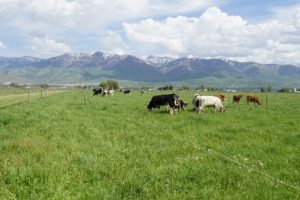
Objective 1. Determine the influence of dairy breed on DMI and feed efficiency: All heifers will be weighed, body condition scored, and have blood samples drawn at the initiation of grazing, and at the end of every 35 day grazing cycle thereafter. Blood work will entail an assay for insulin-like growth factor 1 (IGF1; produced mainly by liver and is the primary mediator of GH production and release). Blood will be collected from the coccygeal vein into heparinized vacutainer tubes and stored on ice until processed. Blood samples will be analyzed for IGF-I in duplicate using the Human IGF-I Quantikine ELISA Kit (SG100; R&D Systems) by following manufacturer-recommended procedures [30,31].
Pre-grazed and post-grazed herbage samples will be collected throughout the experiment just prior to (pre-) and immediately after (post-) heifer rotation to the next paddock, by hand-clipping two random quadrats (0.25 m2) per paddock to a stubble height of 3.8 cm. Post-graze samples will be taken immediately adjacent to the pre-grazing samples, unless it was in an area that the heifers have defecated or lain. Herbage samples will be placed into a paper bag and dried to a constant weight at 60°C and weighed to determine herbage mass. Pre- and post-grazing compressed sward heights (cm) will be measured each time herbage is clipped, and at 24- and 48-hours after grazing is initiated, using a rising plate meter (RPM) (Jenquip, Fielding NZ). Sward height will be measured with the RPM directly over each pre- and post-graze clipped quadrat and as the mean of 30 measurements taken in a ‘w’ pattern throughout each paddock. Individual quadrat herbage mass measurements will be regressed against the respective RPM measurements, forcing a zero intercept as described by Dillard, et al. [32], to develop equations that predicts herbage mass. Pre- and post-grazing herbage mass will be converted to average herbage allowance as described by Sollenberger, et al. [33] for rotational stocking, which accounts for changes in herbage mass during the 3.5-day stocking period. Herbage mass and height will also be converted to herbage bulk density (kg/m3) following McGilloway, et al. [34].
Dried herbage samples will be ground to pass through a 1-mm screen using a Thomas Wiley Laboratory Model 4 mill (Arthur H Thomas Co, Swedesboro, NJ, USA), and scanned with a Foss XDS near-infrared reflectance spectroscopy (NIRS) instrument (Foss, Eden Prairie, MN, USA) to determine nutritive value of the feed on offer. The most recent NIRS equations, developed by the NIRS Forage and Feed Testing Consortium (Hillsboro WI, USA), will be used to predict nutritive value, resulting in estimates of crude protein (CP), neutral detergent fiber (NDF), acid detergent fiber (ADF), acid detergent lignin (ADL), in vitro true digestibility (IVTD), NDF digestibility (NDFD), fatty acids (FA), water soluble carbohydrates (WSC), and ash. Metabolizable energy (ME) will be calculated as Total digestible nutrients × 0.04409 × 0.82 [35]. In addition, the proportion of BFT in each clipped sample will be determined with NIRS using a grass-legume equation developed by Waldron, et al. [13] and validated by hand-separating one-half of all clipped grass-BFT samples. Condensed tannin concentrations will be predicted for the pre- and post-grazed birdsfoot trefoil portion of the separated grass-BFT samples using an NIRS equation developed by Grabber et al. [36,37], and CT % in the total herbage mass calculated.
Estimates of DMI will be based upon herbage disappearance and calculated as the difference between pre-grazing and post-grazing herbage mass [38], and reported as kg/heifer/day, and normalized to animal units (AU) to account for differences in breed size and growth performance, where an AU will be calculated as 50% of metabolic mature body weight for each breed [39]. Feed efficiency, the relative ability to convert nutrients into growth, for each breed will ascertained by studying the relationships between DMI and/or ME intake with heifer growth performance (e.g., weight gain) [40]. Both gross feed efficiency (ratio of weight gain to intake) and residual feed intake (RFI; the difference between actual intake and intake predicted from growth performance) will be calculated [10,11,41].
Heifer growth, herbage physical and chemical characteristics, DMI, and feed efficiency data will be analyzed using the Proc Mixed procedure of SAS, and the effects of dairy breed and pasture-type treatments and their interactions will be reported. Multivariate (e.g., PCA) and regression analyses will be conducted to determine which herbage characteristics are associated with breed and pasture-type differences [42]. Heifer growth, DMI, and feed efficiency comparisons will be made between pasture versus TMR treatments.
Objective 2. Evaluate the influence of dairy breed on nutrient leaching: Soil water (leachate) nitrogen will be monitored by means of 90-cm suction-cup lysimeters (below the root zone). Leachate will be collected every week during the growing season, and as much as possible throughout the early spring and late fall. The leachate will be analyzed for nitrate-nitrite concentration using QuickChem Method 10-107-04-1-C on the Lachat Auto-analyzer. Leachate concentration and volume will be used to determine total leachate N.
To monitor any potential buildup of soil nitrogen, soil samples to a depth of 30 cm will be collected prior to grazing, and in the fall after the growing season each year. To account for the variability that may result from grazing, ten soil cores will be taken in each plot and combined to make a composite soil sample. Composite soil samples will be analyzed for available nitrogen (NO3-N) using potassium chloride on the Lachat Auto-analyzer, QuickChem Method 10-107-04-1-C.
Nutrient cycling and N-use efficiency will be evaluated by studying the relationships between herbage N intake (Object. 1) with N loss in leachate and the soil (Object. 2) and fecal, urine urea, and blood urea N (data obtained separate from this proposal). Breed effect on N leaching and N-utilization efficiency when grazing grass monocultures vs grass-BFT mixtures will be determined and differences reported. Data will be analyzed using SAS PROC Mixed with Repeated Measures.
Objective 3. Ascertain the influence of dairy breed on the economic sustainability of pasture-based heifer development: Partial budgeting techniques will be used to determine the cost differences from each heifer development program. Costs associated with procuring and feeding the different breeds of heifers will be determined. These costs will be subdivided for each of the breeds according to pasture-type (MONO or MIXED) and TMR-fed. The cost of the TMR feeds will be based on the last 5-years average costs to minimize bias in yearly feed prices.
The partial budgets will be used to quantify the impact of heifer performance, under each pasture-type and TMR, on the economic value of the four breeds following the methodology described by Feuz, et al. [29]. In brief, price comparisons for the value of an open heifer versus a bred heifer and for different weight heifers will be made. The last 5-years prices will be used to value the dairy heifers. Based upon previous results [28], a single-service conception rate using gender-sorted semen of 53% for the TMR-fed heifers will be assumed. As per current available literature [43], all pasture-fed heifers will be penalized a 5% conception rate decrease compared to TMR-fed heifers. Furthermore, as per Hayes, et al. [44] heifers on MONO treatments with lesser body weight gain compared to their respective MIXED cohorts will be penalized an additional 5% decrease in conception rate.
Ultimately, the partial budgets will be used to determine the most profitable breed/development method (i.e., pasture-type and TMR) of raising dairy heifers. Actual costs and revenue differences for each breed and alternative pasture-based program will be combined to determine the breed and program that offers the best net annual financial impact.
Objective 1: Determine the influence of dairy breed on DMI and feed efficiency
- Heifers were weighed (BW), body condition scored (BCS), and blood and rumen fluid samples drawn at the initiation of grazing, and at the end of every 35 day grazing cycle during 2021. Blood and rumen fluid assays are ongoing. These data were combined with data from 2020. The heifer performance data from 2020 were analyzed and reported as part of the requirements for a Utah State University M.S. thesis (Sawyer Fonnesbeck). The main results of the thesis are summarized as follows:
- We saw that BFT significantly increased ADG for all breeds. Heifers which grazed the MIX treatments averaged 0.48 kg of gain/day, whereas heifers on MONO pastures averaged 0.28 kg/day. Overall changes in BCS were significantly affected by both the differences in pasture treatment and breed of the animals (Figure 1).
- The different treatments did not cause any significant differences in fecal egg count (FEC) or total rumen volatile fatty acids (VFA) concentrations.
- Overall, we found that Jerseys were able to gain a higher percentage of their mature body weight and maintain their body condition better, while grazing, than heifers of other breeds (Figure 2).
- We also determined that grazing BFT can have noticeable positive effects on ADG, BCS, and change in percent mature BW.
-
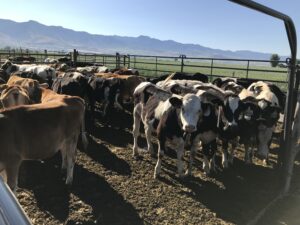
Sorting and weighing heifers on project SW21-927. 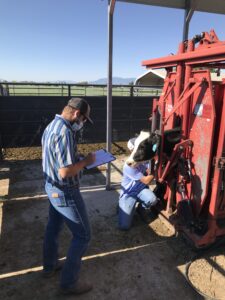
Weighing heifers on project SW21-927.
- Grazing intake and herbage measurements were collected during the 2021 grazing season and used to determine dry matter intake (DMI) and feed efficiency. These data were combined with data from 2020. The herbage data were analyzed and will be reported as part of the requirements for a Utah State University M.S. thesis (Michael Greenland). To date, the main results of the thesis are summarized as follows:
- We used herbage disappearance to determine DMI. Both feed conversion efficiency (FCE) and residual feed intake (RFI) were derived using heifer weight and DMI. All measures were normalized to 40% metabolic mature body weight of the corresponding dairy breed to account for difference in size and growth of the heifers.
- We observed greater DMI on grass-BFT mixtures. Among breeds, Holstein had the greatest DMI, then the two crossbreds, and Jersey had the least (Table 1).
- Feed efficiency was most favorable for Jersey, less efficient for both crossbreds, and Holsteins showed variable results depending upon efficiency measure (Table 1, Figure 3).
- Grazing adaptation defined as change in DMI during successive 24+ h increments over the 3.5 d grazing period was also considered, and DMI declined throughout the grazing period for all breeds similarly on both pasture-types. In addition, no breed × pasture-type interactions were found for DMI, FCE, or RFI suggesting that no breed had an advantage on higher quality (grass-BFT mixture or early grazing period) or lower quality (grass monoculture or late grazing period) forage.
- Multivariate analyses will be conducted (in 2022) to identify forage quality parameters associated with DMI and feed efficiency.
-
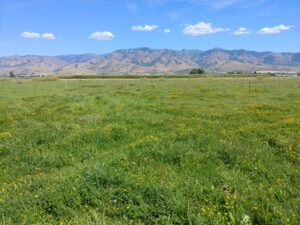
Grass-birdsfoot trefoil pastures in project SW21-927. 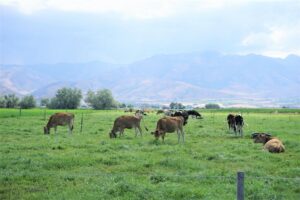
Dairy heifers grazing pastures on project SW21-927. 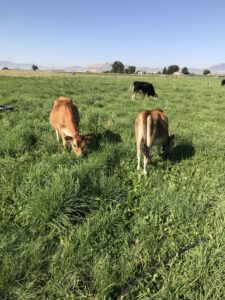
Jersey heifers grazing on project SW21-927
- On-farm trials –
- The three collaborating producers received rising plate meters (RPM) and training about how to use the RPM to determine pre- and post-grazing herbage mass, and estimate subsequent intake.
Objective 2: Evaluate the influence of dairy breed on nutrient leaching
- In 2021, field data were collected, and sample analyses are ongoing. Field data collected included the following:
- 1) plant samples were collected before and after each grazing event and dried for later analysis;
- 2) soil samples were collected in the fall at the beginning of the study for a baseline reading, and in the spring, prior to grazing, and in the fall after the growing season using a Giddings® soil extraction instrument to a depth of 1.524 meters. Soil samples were also collected in the spring of the third year to monitor nutrient movement;
- 3) soil water (leachate) nitrogen was monitored by lysimeters and leachate collected every two weeks during the growing seasons, and as close as possible to every two weeks during the winter months; and
- 4) urine and feces were collected from heifers at weigh-ins.
- Samples will be analyzed for nitrate, ammonia, urea, and total nitrogen and carbon.
Objective 3: Ascertain the influence of dairy breed on the economic sustainability of pasture-based heifer development.
- In 2021, nothing to report on economic analysis. These analyses will begin in summer of 2022.
Table and Figures for Research Results
Table 1. Measures of dry matter intake (DMI), NEm, NEg, and NDF intake and feed efficiency for two [grass-birdsfoot trefoil mixture (MIXED) and grass monoculture (MONO)] pasture treatments and four dairy breeds in a heifer grazing study conducted in Lewiston, Utah, USA during 2019, 2020, and 2021[1]
|
|
Pasture-type (PT) |
|
Breed (BR) |
|
Probability |
||||||||
|
MIXED |
MONO |
Jersey |
Holstein |
H×J |
3-breed |
PT |
BR |
PT× BR |
|||||
|
BW |
|
|
|
|
|
|
|
|
|
||||
|
Start %MBW, % |
0.32a |
0.32a |
0.33a |
0.27b |
0.34a |
0.33a |
0.59 |
<0.01 |
0.84 |
||||
|
End %MBW, % |
0.40a |
0.38b |
0.43a |
0.33c |
0.41ab |
0.39b |
<0.01 |
<0.01 |
0.65 |
||||
|
Intake[2] |
|
|
|
|
|
|
|
|
|
||||
|
DMI/100kg, kg |
2.0a |
1.6b |
2.1a |
1.8b |
1.8b |
1.6c |
<0.01 |
<0.01 |
0.52 |
||||
|
NEm/100kg, 100 MJ |
13.2a |
10.1b |
13.1a |
11.4b |
11.4b |
10.6c |
<0.01 |
<0.01 |
0.38 |
||||
|
NEg/100kg, 100 MJ |
6.4a |
4.5b |
6.2a |
5.3b |
5.3b |
5.0b |
<0.01 |
<0.01 |
0.22 |
||||
|
DMI/AU[3], kg |
4.4a |
3.6b |
3.6c |
4.4a |
3.9b |
4.0b |
<0.01 |
<0.01 |
0.21 |
||||
|
NEm/AU, 100 MJ |
29.2a |
22.1b |
23.2c |
28.3a |
25.2b |
26.0b |
<0.01 |
<0.01 |
0.15 |
||||
|
NEg/AU, 100 MJ |
14.3a |
10.0b |
10.9c |
13.3a |
11.8b |
12.4b |
<0.01 |
<0.01 |
0.10 |
||||
|
NDF, %BW |
1.1a |
0.9b |
1.2a |
1.0b |
1.0b |
0.9c |
<0.01 |
<0.01 |
0.49 |
||||
|
Efficiency[4] |
|
|
|
|
|
|
|
|
|
||||
|
FCE |
0.12a |
0.09b |
0.12a |
0.11ab |
0.10bc |
0.09c |
<0.01 |
<0.01 |
0.08 |
||||
|
RFI/100kg |
0.15b |
-0.15a |
0.00ab |
-0.07a |
0.05b |
0.02b |
<0.01 |
0.03 |
0.47 |
||||
|
NEm Conversion |
0.02a |
0.01b |
0.02a |
0.02ab |
0.01bc |
0.01c |
<0.01 |
<0.01 |
0.12 |
||||
|
NEg Conversion |
0.04a |
0.03a |
0.04a |
0.04ab |
0.03bc |
0.03c |
0.07 |
0.02 |
0.12 |
||||
|
RFI/AU |
0.27b |
-0.27a |
-0.38a |
0.16b |
0.04b |
0.17b |
<0.01 |
<0.01 |
0.68 |
||||
|
RFI/AUcov |
0.30b |
-0.30a |
-0.17a |
-0.06ab |
0.12c |
0.11bc |
<0.01 |
<0.01 |
0.72 |
||||
a-c Mean values within same row of breed or pasture-type with different superscripts signifying significant difference (P=0.05).
[1] Dairy breed included Holstein-Jersey crossbred (HxJ), and a 3-breed rotational crossbred of Montbéliarde-Swedish Red or Viking Red-Holstein (3-Breed).
[2] Apparent DMI measured as the disappearance of herbage mass as determined via a calibrated rising plate meter at pre- and post-grazing of 3.5-d grazing periods. Estimated herbage accumulation during the 3.5-d grazing period and grazing efficiency included in estimates. Estimates include DMI per 100 kg BW (DMI/100kg) and per AU (DMI/AU), net energy for maintaince per 100 kg BW (NEm/100kg) and per AU (NEm/AU), net energy for gain per 100 kg BW (Neg/100kg) and per AU (Neg/AU), and NDF intake as percent BW (NDF).
[3] Animal unit (AU) was defined as 40% of mature BW for each breed where 675, 630, 562.5, and 450 kg are the mature BW for Holstein, ProCross, Holstein-Jersey cross, and Jersey, respectively.
[4] Feed efficiency was measured as feed conversion efficiency (FCE) (i.e., kg gain/kg DMI), NEm and NEg conversion (i.e., BW gain/NE intake), and residual feed intake (RFI) on a per 100 kg BW basis (RFI/100kg), per AU basis (RFI/AU), and per AU basis with the % starting mature BW (%MBW) included as a covariate in regression (RFI/AUcov).
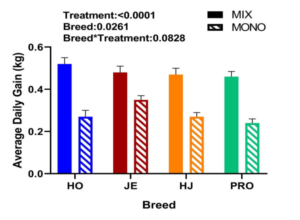
Figure 1. Measurement of Average Daily Gain over the course of a 105-d grazing period for each of four breeds (HO: Holstein, JE: Jersey, HJ: Holstein/Jersey crossbred, PRO: ProCross) with the two assigned treatments (MIX: grass +BFT, MONO: grass only). A total of 192 heifers were used over the course of 2 years (n=24 animals/breed/year) with equal numbers of each breed represented in each treatment. Significance set at P<0.05.
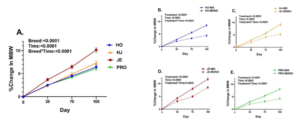
Figure 2. Effect of breed (A) and treatment (B-E) on the cumulative change in percent Mature Body Weight (MBW) over the course of a 105-d grazing period for each of the four breeds (HO: Holstein, JE: Jersey, HJ: Holstein/Jersey crossbred, PRO: ProCross) with the two assigned treatments (MIX: grass +BFT, MONO: grass only). A total of 192 heifers were used over the course of 2 years (n=24/breed/year) with equal numbers of each breed represented in each treatment. Change in percent MBW was calculated at Day35, Day70, and Day105 to show the overall percent change MBW at any given time. Significance set at P<0.05.
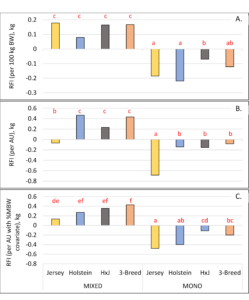
Figure 3. Residual feed intake on a 100 kg BW basis (RFI/100kg) (A.), animal unit (AU) basis (RFI/AU) (B.), and an AU basis further corrected by using a covariate of initial % mature BW (RFI/AUcov) (C.) for grass-birdsfoot trefoil mixed (MIXED) and grass monoculture (MONO) pasture treatments of a dairy breed by pasture-type heifer grazing study conducted in Lewiston, Utah, USA during 2019, 2020, and 2021. Four dairy breeds, Jersey, Holstein, Holstein-Jersey crossbred, and Montbéliarde-Swedish or Viking Red-Holstein crossbreds (3-breed), were compared using rotational stocking of three 35-d cycles. Standard AUs were defined as a heifer at 40% of metabolic mature BW for each breed. Letters represent LSD (P=0.05) differences based upon the standard error of the pasture-type × breed means (0.09, 0.19, 0.19 for A., B., C., respectively; n=9).
Research Outcomes
Education and Outreach
Participation Summary:
Consultations for 2021 annual report:
- Responded to 15 questions (phone calls, emails, on-site visits) about grass-legume mixtures for pasture, including how to establish and manage grazing.
Webinars, talks and presentations for 2021 annual report:
Miller, R., B. Waldron, S. C. Isom, K. Thornton-Kurth, K. Rood, E. Creech, M. Peel, J. Hadfield, R. Larson, and M. Rose. 2022. Improving Production and Minimizing Nutrient Loss in Grazing Systems through the Use of Grass-Legume Mixtures. eXtension Waste to Worth: Advancing Sustainability in Animal Agriculture. Waste-to-Worth 2022. Participants: 50 farmers/ranchers, 200 agricultural professionals, 100 academia.
Fonnesbeck, Sawyer. Influence of cattle breed and forage type on organic dairy heifer performance. M.S. thesis defense presentation. Utah State University, Logan. August 11, 2021. Participants: 3 farmers/ranchers, 2 agricultural professionals, 35 academia.
Workshop / field days for 2021 annual report:
Utah State University Lewiston Pasture Research Farm field day. July 28, 2021. Lewiston, Utah. Participants: 41 total. 15 farmers/ranchers, 11 agricultural professionals, 15 academia. The following presentations related to this project were given:
- Clay Isom. Dairy heifer grazing project overview.
- Michael Greenland, USU graduate student. Dry Matter Intake and Feed Efficiency of Four Dairy Breeds in Pasture-Based Heifer Development.
- Sawyer Fonnesbeck, Idaho State University Extension and former graduate student on project. The Influence of Cattle Breed and Forage Type on Dairy Heifer Performance
- Rhonda Miller. N-Cycling in Organic Dairy Grazing Systems.
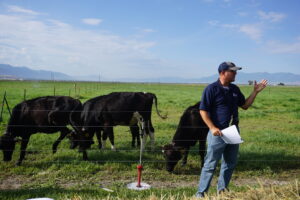
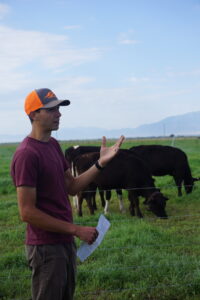
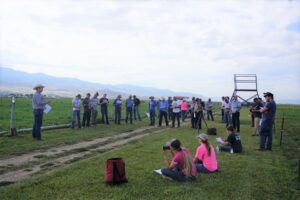
Other Educational and Outreach Activities for 2021 annual report
A web site for the project was established through eOrganic in a previous related Western SARE grant, SW17-046 (found at https://eorganic.info/node/33809; verified 4/28/22). The project SW21-927 is an extension and continuation and will be using the same website. Information on the website will be updated to reflect the new project. As publications, presentations and trial results from the projects become available, we will make them available here.
Publications for 2021 annual report
Miller, R., B. Waldron, S. C. Isom, K. Thornton-Kurth, K. Rood, E. Creech, M. Peel, J. Hadfield, R. Larson, and M. Rose. 2022. Improving Production and Minimizing Nutrient Loss in Grazing Systems through the Use of Grass-Legume Mixtures. eXtension Waste to Worth: Advancing Sustainability in Animal Agriculture. Waste-to-Worth 2022 Proceedings. Available at: https://lpelc.org/improving-production-and-minimizing-nutrient-loss-in-grazing-systems-through-the-use-of-grass-legume-mixtures/.
Miller, R., B. Waldron, C. Isom, K. Thornton-Kurth, K. Rood, E. Creech, M. Peel, M. Rose, and J. Hadfield. 2021. Nutrient Cycling in an Organic Dairy Grazing System. In 2021 American Society of Agronomy Abstracts. Madison, WI: American Society of Agronomy.
Fonnesbeck, Sawyer. Influence of cattle breed and forage type on organic dairy heifer performance.. M.S. thesis, Utah State University, Logan. 2021.
Education and Outreach Outcomes
- • Grass-legume mixtures improve dairy heifer forage intake, health, and performance compared to grass monocultures.
